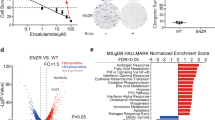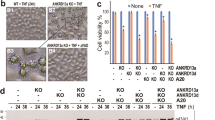Abstract
Colorectal cancer cells are unique in that they escape Fas-mediated cell death in the presence of Fas ligand, and we recently reported that AMP-activated protein kinase-related kinase 5 (ARK5) suppresses cell death signaling mediated by cell death receptor in Akt-dependent manner. In the current study, therefore, we examined whether ARK5 is involved in the escape from Fas-mediated cell death of colorectal cancer cells. Among 10 cell lines, ARK5 mRNA expression was observed in LoVo, SW480, and SW1116 cell lines. Interestingly, SW480 and SW1116 cell lines, but not LoVo cell line, showed expressions of both Fas ligand (FasL) and Fas mRNAs. SW620 cell line also showed FasL mRNA; however, Fas and ARK5 mRNAs were not detected. Furthermore, well-coincided expression among ARK5, FasL, and Fas mRNAs was observed in tumor tissues from patients with colorectal cancer, suggesting the suppression of FasL/Fas system-induced cell death by ARK5 in colorectal cancer cell lines. Intensive cell death, which was dependent on the FasL/Fas system was encountered when ARK5 antisense RNA (ARK5/AS) was introduced into SW480 cells. FLIP was expressed in only ARK5 mRNA-expressing cell lines, and ARK5/AS induced FLIP cleavage in a caspase-6-dependent manner. Amino-acid sequence analysis of caspase-6 revealed two putative sites of phosphorylation by ARK5 at Ser80 and Ser257. Although active caspase-6 overexpression induced cell death in SW480 and DLD-1 cell lines, SW480 cells, but not DLD-1 cells, exhibited strong resistance to procaspase-6 overexpression. Moreover, mutant caspase-6, in which the Ser257 was substituted by Ala (caspase-6/SA), induced cell death and FLIP degradation, even in SW480 cells. Active ARK5 was found to phosphorylate wild-type caspase-6 in vitro, but not caspase-6/SA, and the prevented activation of caspase-6 was promoted due to its phosphorylation by active ARK5 in vitro. On the basis of the results of this study, we propose that ARK5 negatively regulates procaspase-6 by phosphorylation at Ser257, leading to resistance to the FasL/Fas system.
This is a preview of subscription content, access via your institution
Access options
Subscribe to this journal
Receive 50 print issues and online access
$259.00 per year
only $5.18 per issue
Buy this article
- Purchase on Springer Link
- Instant access to full article PDF
Prices may be subject to local taxes which are calculated during checkout







Similar content being viewed by others
Abbreviations
- AMPK:
-
AMP-activated protein kinase
- ARK5:
-
AMPK-related kinase 5
- DISC:
-
death-inducing signaling complex
- DD:
-
death domain
- DED:
-
death effector domain
- Fas:
-
Fas antigen
- FasL:
-
Fas ligand
- cFLIP:
-
cellular FLIP
- cFLIPs:
-
short form of cFLIP
- DN-Akt1:
-
dominant-negative Akt1
- DN-ARK5:
-
dominant-negative ARK5
- ARK5/AS:
-
antisense RNA of ARK5
References
Bennett MW, O'Connell J, Houston A, Kelly J, O'Sullivan GC, Collins JK and Shanahan F . (2001). J. Clin. Pathol., 54, 598–604.
Berman RS, Portera CAJ and Ellis LM . (2001). Cancer Treat. Res., 109, 183–206.
Brazil DP, Park J and Hemmings BA . (2002). Cell, 111, 293–303.
Brunet A, Bonni A, Zigmond MJ, Lin MZ, Juo P, Hu LS, Anderson MJ, Arden KC, Blenis J and Greenberg ME . (1999). Cell, 96, 857–868.
Cardone MH, Roy N, Stennicke HR, Salvesen GS, Franke TF, Stanbridge E, Frisch S and Reed JC . (1998). Science, 282, 1318–1321.
Chinnaiyan AM, O'Rourke K, Tewari M and Dixit VM . (1995). Cell, 81, 505–512.
Datta SR, Brunet A and Greenberg ME . (1999). Genes Dev., 13, 2905–2927.
Datta SR, Dudek H, Tao X, Masters S, Fu H, Gotoh Y and Greenberg ME . (1997). Cell, 91, 231–241.
Ding EX, Hizuta A, Morimoto Y, Tanida T, Hongo T, Ishii T, Yamano T, Fujiwara T, Iwagaki H and Tanaka N . (1998). Res. Commun. Mol. Pathol. Pharmacol., 101, 13–24.
Esumi H, Izuishi K, Kato K, Hashimoto K, Kurashima Y, Kishimoto A, Ogura T and Ozawa T . (2002). J. Biol. Chem., 277, 32791–32798.
Fernandes-Alnemri T, Litwack G and Alnemri ES . (1994). J. Biol. Chem., 267, 30761–30764.
Hardie DG and Carling D . (1997). Eur. J. Biochem., 246, 259–273.
Hardie GD, Carling D and Carlson M . (1998). Annu. Rev. Biochem., 67, 821–855.
Hashimoto K, Kato K, Imamura K, Kishimoto A, Yoshikawa H, Taketani Y and Esumi H . (2002). Biochem. Biophys. Res. Commun., 290, 263–267.
Irmler M, Thome M, Hahne M, Schneider P, Hofman K, Steiner V, Bodmer J-L, Schroter M, Burns K, Mattman C, Rimoldi D, French LE and Tschopp J . (1997). Nature, 388, 190–195.
Izuishi K, Kato K, Ogura T, Kinoshita T and Esumi H . (2000). Cancer Res., 60, 6201–6207.
Kato K, Ogura T, Kishimoto A, Minegishi Y, Nakajima N, Miyazaki M and Esumi H . (2002). Oncogene, 21, 6082–6090.
Kelly MM, Hoel BD and Voelkel-Johnson C . (2002). Cancer Biol. Ther., 1, 520–527.
Kim Y, Suh N, Sporn M and Reed JC . (2002). J. Biol. Chem., 277, 22320–22329.
Kusakai G, Suzuki A, Ogura T, Miyamoto S, Ochiai A, Kaminishi M and Esumi H . (2004). Am. J. Pathol., 164, 987–995.
Leithauser F, Dhein J, Mechtersheimer G, Koretz K, Bruderlein S, Henne C, Schmidt A, Debatin K-M, Kramer PH and Moller P . (1993). Lab. Invest., 69, 415–429.
Liu K and Abrams SI . (2003). J. Immunol., 170, 6329–6337.
Nagata S . (1997). Cell, 88, 355–365.
Nakanishi K, Sakamoto M, Yasuda J, Takamura M, Fujita N, Tsuruo T, Todo S and Hirohashi S . (2002). Cancer Res., 62, 2971–2975.
O'Connell J, Bennett MW, O'Sullivan GC, Roche D, Kelly J, Collins JK and Shanahan F . (1998). J. Pathol., 186, 240–246.
Peso L, Gonzalez-Garcia M, Page C, Herrera R and Nunez G . (1997). Science, 278, 687–689.
Peudo-Eberl L, Guillou L, Saraga E, Schroter M, French LE, Tschopp J and Juillerat-Jeanneret L . (1999). Int. J. Cancer, 81, 772–778.
Shiraki K, Tsuji N, Shioda T, Isselbacher KJ and Takahashi H . (1997). Proc. Natl. Acad. Sci. USA, 94, 6420–6425.
Sledz CA, Holko M, de Veer MJ, Silverman RH and Williams BR . (2003). Nat. Cell Biol., 5, 834–839.
Suzuki A, Kusakai G, Kishimoto A, Lu J, Ogura T and Esumi H . (2003a). Oncogene, 22, 6177–6182.
Suzuki A, Kusakai G, Kishimoto A, Lu J, Ogura T, Lavin MF and Esumi H . (2003b). J. Biol. Chem., 278, 48–53.
Suzuki A, Lu J, Kusakai G, Kishimoto A, Ogura T and Esumi H . (2004). Mol. Cell. Biol., 24, 3526–3535.
Thome M, Schneider P, Hofmann K, Fickenscher H, Meinl E, Neipel F, Mattmann C, Burns K, Bodmer JL, Schroter M, Scaffidi C, Krammer PH, Peter ME and Tschopp J . (1997). Nature, 386, 517–521.
Thornbery NA, Rano TA, Peterson EP, Rasper DM, Timkey T, Garcia-Calvo M, Houtzager VM, Nordstorm PA, Roy S, Vaillancourt JP, Chapman KT and Nicholson DW . (1997). J. Biol. Chem., 272, 17907–17911.
Watanabe-Fukunaga R, Brannan CI, Itoh N, Yonehara S, Copeland NC, Jenkins NA and Nagata S . (1992). J. Immunol., 148, 1274–1279.
Wyllie AH, Kerr JFR and Currie AR . (1980). Int. Rev. Cytol., 68, 251–306.
Acknowledgements
We thank Professor Bruce E Kemp and Dr Ian Jennings, St Vincent's Institute of Medical Research, for their kind discussion and advise about the preparation of E. coli expression system of ARK5. This work was partly supported by a Grant for the 2nd Term Comprehensive 10-year Strategy of Cancer Control from the Ministry of Health, Welfare and Labour and a Grant for the Medical Frontier Program from the Ministry of Health, Welfare, and Labour. AS, GK, and SM are recipients of a Research Resident Fellowship from the Foundation for Promotion of Cancer Research.
Author information
Authors and Affiliations
Corresponding author
Rights and permissions
About this article
Cite this article
Suzuki, A., Kusakai, Gi., Kishimoto, A. et al. Regulation of caspase-6 and FLIP by the AMPK family member ARK5. Oncogene 23, 7067–7075 (2004). https://doi.org/10.1038/sj.onc.1207963
Received:
Revised:
Accepted:
Published:
Issue Date:
DOI: https://doi.org/10.1038/sj.onc.1207963
Keywords
This article is cited by
-
A Review on Caspases: Key Regulators of Biological Activities and Apoptosis
Molecular Neurobiology (2023)
-
Palmitoylation of caspase-6 by HIP14 regulates its activation
Cell Death & Differentiation (2017)
-
Overexpression of NUAK1 is associated with disease-free survival and overall survival in patients with gastric cancer
Medical Oncology (2014)
-
ARK5 is associated with the invasive and metastatic potential of human breast cancer cells
Journal of Cancer Research and Clinical Oncology (2012)
-
A new role of NUAK1: directly phosphorylating p53 and regulating cell proliferation
Oncogene (2011)



